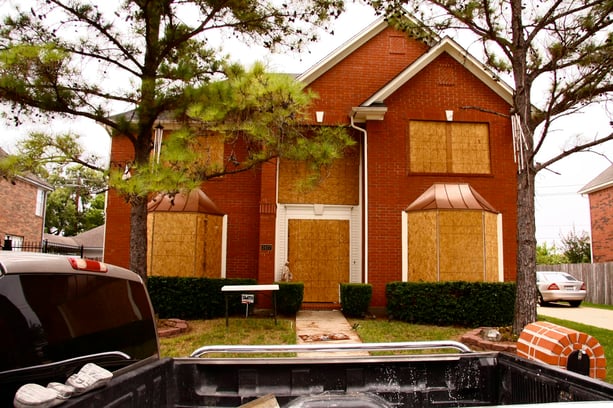As spring and summer storms rip through neighborhoods, homes can suffer damage from high winds, hail, rain, and falling trees or debris. Glass-paned windows, especially older styles, can be especially vulnerable to strong weather. If your windows have been damaged in a storm, here’s what to do.

Stay Safe
During a storm, if your windows are damaged or broken, move yourself and your family away from the windows and broken glass into an interior room with few or no windows (like a bathroom or laundry room). If the winds are slow enough for you to cover the window opening, attempt to do so. Use whatever you can find to keep out as much rain and flying debris as possible, such as a tarp, shower curtain, or bedsheet. If portions of glass are hanging precariously and the storm is ongoing, if it is safe to do so, consider breaking out the remaining glass before covering over the opening.
Assess the Damage
If possible, wait for the storm to pass before surveying your property to evaluate the extent of the damage. Clean up glass; if you are unable to completely clean up the outside areas, cordon off areas that may harbor shards and be hazardous to children or visitors. Check your home from top to bottom to evaluate damage to the roof, siding, and foundation in addition to any broken windows. Also pay attention to loosened shingles, siding, or shutters around your windows. Examine the inside walls around damaged windows for water infiltration or leaks.
Contact Your Insurer
Once you’ve evaluated the damage, you should call your insurance company immediately. Send them pictures, videos, or other documentation of damage if they request it, and keep all receipts for repairs and emergency purchases. Your insurer will be able to tell you your policy requirements regarding temporary remediation to prevent additional damage and make suggestions about repair services.
Prevent Further Damage
After assessing the damage and talking to your insurer, you should protect your home from further harm. (Make sure you discuss this with your insurance company to ensure you remain compliant with your policy provisions.) Generally, you’ll want to cover up broken windows with plywood or plastic. A house window can be temporarily covered with plywood cut to fit the window until a replacement can be installed. If you find an area where water is leaking in, clean up any water that has made its way into your home to prevent mold formation, and patch the leak as best you can to prevent additional infiltration.
Invest in Durable, Weather-Resistant Replacement Windows & Shutters
If you live in an area that experiences frequent severe weather events, and you have had multiple issues with broken windows as a result of weather, you may want to investigate high impact storm windows. These can protect the integrity of your windows through all but the strongest storms, but they are priced at a premium. Typically, they have two panes of tempered glass along with plastic film. The glass itself is extremely resistant to impact, and the film prevents it from shattering into the home. Many insurance companies will provide some discounts for installing these windows because of the extra protection they provide. Many other homeowners in high-risk areas invest in storm shutters, either roll-up or accordion-style. These can be pulled over the windows and secured in place before a storm hits, providing a high level of protection at a lower cost.
Other Ways to Fortify Your Windows
To add protection and durability to existing windows, you can install hurricane film, a clear plastic covering that you place over the windows. While it won’t prevent a window from breaking, if the glass breaks during a storm, the film prevents the glass shards from exploding into a room. Hurricane film is affordable and unobtrusive, and it also blocks UV rays (protecting carpets and furniture from fading as a result of direct sunlight).
If a serious storm is approaching, a very effective way to fortify your windows and protect your belongings is to secure plywood over your windows. 5/8” thick plywood is recommended, which can be painted or sealed for even more water protection. You should cut, measure, and properly install the plywood before a storm hits; you can label and store the covers for re-use if you are in an area prone to storms. Make sure you properly secure the plywood with the appropriate fasteners for your home so the covers don’t rip off in high winds and cause further damage.
If your windows have been damaged in a storm, talk to Hedrick Construction about your options for window replacement. We offer a spectrum of beautiful window styles, quality craftsmanship, and expert installation. Contact us for a professional inspection of your home and free estimates for all of your Iowa roofing, siding, and window repair and replacement needs.








Comments